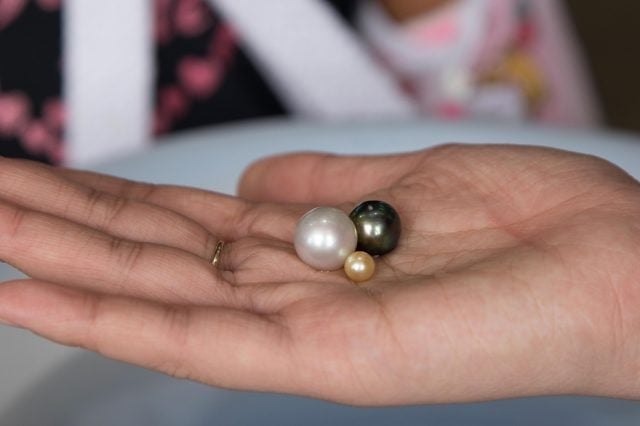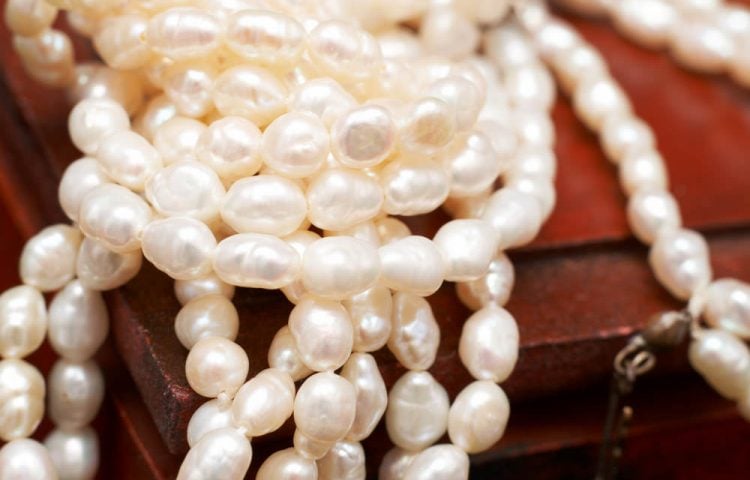Authentic pearls are stunning and valuable – but how to tell if a pearl is real? These days, the market is full of counterfeits and imitations, especially in the gemstone business. The pearl industry is not an exception. Before, pearls were only found in the wild. This made pearls very rare. Today, technology makes fake pearls look remarkably real, which means that the probability of purchasing faux pearls is high.
Counterfeit pearl products change over time. An imitation pearl (made from glass or plastic) may not have the same features as a counterfeit pearl a couple of years ago. Therefore, the best way to know how to tell if pearls are real is by knowing the features of an authentic pearl. So let’s learn how to tell if a pearl is real.
Here’s the best tip on how to tell if pearls are real:
The Tooth Test: Simply rub the pearl against your tooth, softly. If the pearl is natural or cultured, you will feel the surface as gritty. If the pearl is a faux gem, then the surface will feel smooth.

Freshwater pearls are real, cultured pearls, grown in lakes, rivers, as well as ponds. Most Freshwater pearls are white and resemble Akoya pearls, but they also produce a variety of pastel shades, including pink, lilac and peach. These types of pearls are generally more affordable than saltwater types due to their abundance.
Cultured pearls are genuine pearls, but they are formed with human intervention. The process involves inserting an irritant inside the mollusk. As a defense mechanism, a fluid is released to coat the irritant, later forming the pearl. Natural pearls are formed exclusively by nature and they are much more rare and valuable than cultured pearls.
A natural pearl occurs in an oyster’s shell when an irritant, such as a grain of sand gets inside the oyster (or mollusk).
Tips How to Tell if a Pearl is Real or Fake:
Feeling the Pearl

The first and the easiest way to tell if a pearl is real is by feeling it. When you touch a real pearl, it feels cool and warms up when worn. Fake pearls feel warm, and can be sticky when felt with fingers. In fact, the coolness to the touch tip, although simple, is one of the fastest and most efficient ways to tell if a pearl is authentic. A natural pearl has a unique weight. Counterfeits may have a weight that is ridiculously small or an exaggerated heavyweight. Fake pearls made of plastic will feel very light, while glass pearls will be heavier.
How to Tell is Pearls Are Real: Shape and Surface
Real pearls come in different sizes and shapes, unlike the counterfeit ones that come in basically one-size-and-shape-fits-all. Real pearls do not look identical to one another. In fact, each is unique in its own way. Fake pearls will appear perfectly round and have a very smooth surface, while real pearls will present slightly off-round shapes and a grittier surface.

PEARL SPOTLIGHT:
The most common misconception about real pearls is that these types of pearls are extremely expensive, which is why some choose imitations over cultured pearls. But gorgeous gems like Freshwater Pearls make stunning jewelry pieces such as timeless stud earrings, single pearl necklaces or pearl dangle earrings, complete with very attractive price tags.
Types of Pearls
There are two main types of pearls out there: saltwater and freshwater pearls. Freshwater pearls come with more affordable prices as they are more abundant and slightly less lustrous compared with saltwater varieties. Saltwater gems include these types of pearls:
- Akoya Pearls
- Hanadama Pearls
- Tahitian Pearls
- White South Sea Pearls
- Golden South Sea Pearls
How to Tell Real Pearls: The Luster of Real Pearls VS Fake Pearls

Another way of telling whether a pearl is real is by checking its luster. A real pearl has a unique pearl luster and a natural, rough feel. The luster should be bright, deep and sharp and the pearl should have a subtle overtone. A real pearl’s luster will look sharp under direct light, while a fake pearl’s luster will look slightly chalky or ‘plasticky’. A quick trick on how to tell real pearls is to observe the genuine pearls’ ability to reflect light – unlike the imitations, which have no reflection capabilities.
What Is the Tooth Test?
The tooth test is the easiest way to see if you are in the possession of authentic pearls or artificial pearls. Take a pearl and gently rub it against your front teeth. A real pearl’s surface will feel gritty – while fake plastic pearls and glass pearls will feel smooth.
This is because a real pearl has small ridges on its surface. These ridges may not be visible to the naked eye. However, experts and jewelers can check the “natural flaws” in a pearl using a magnifying object. In real pearls, these same ridges can be felt using the teeth. However, testing with the teeth is not accepted by many retailers.
How to Tell if a Pearl Is Real – Clear Giveaways
Sometimes, identifying real pearls is easy since there are many bad imitations out there. More often than not, all you need to do is inspect the outer surface for clear giveaways. Firstly, inspect the pearl’s surface, especially around the drill hole. If you spot any chipped paint around the hole, then you aren’t looking at an authentic gem.
The Drop & Bounce Test
Fact is, real pearls bounce when dropped. To perform this simple test, drop your pearl from around two feet on a glass surface. A marble floor will also work for this quick experiment. A real pearl will bounce at least one foot in height.
How Can You Tell if Pearls Are Real: Rubbing Two Pearls Together
When a real pearl is rubbed against another real pearl, a pearl powder is produced. The same effect is seen if a real pearl is lightly scrubbed using a knife. If two fake pearls are rubbed against each other, the process is smooth, and no powder is produced.
Knock two real pearls against each other, and a soft and unique sound is produced. When counterfeit pearls are knocked together, the sound that is produced is very slight.
How to Tell Real Pearls: Using Fire to Test Pearl Authenticity
While there are many easy ways and simple tests to identify fake, cultured and natural pearls, higher quality fakes require more advanced tests. A reliable method anyone can use to learn how to tell if pearls are real is a naked flame. When you burn a real pearl mildly, the pearl remains shiny, intact and produces no odor. If the flame is consistent for about 2 minutes, the pearl produces a pop sound. A counterfeit pearl coming across a naked fire will produce a bad odor, and it loses its luster.
The Acetone Test
There are special chemical methods that can be used to find out if a pearl is real. A genuine pearl has a relative density of 2.73 and dissolves in hydrochloric acid. Counterfeit pearls don’t react to hydrochloric acid. An authentic pearl is not affected by acetone solution. However, a counterfeit one loses its luster completely when acetone is used.
Final Thoughts
And there you have it: your quick guide on how to tell if a pearl is real! From the coolness to the touch tip to feeling its weight and performing more advanced tests, there are many fail-proof ways to test pearls. Before you buy pearls, be it a pearl necklace, bracelet or a pair of earrings, make sure that you are only shopping from reputable, specialized retailers. Doing so will guarantee that you will own high quality pearls. There are many fake pearl retailers on the market today, but any professional jeweler will be able to provide the best quality real gems, accompanied by a an authenticity certificate. Next up: enjoy a successful shopping spree and enjoy your stunning new gems of the seas!
Curious to find out more on the topic of real pearls? Read our post on How Are Pearls Made and our educational content on How Do Oysters Make Pearls!

JEWELRY SPOTLIGHT
If exquisite luster is what you’re after, then Hanadama Pearl Jewelry is here to cater to your needs. With their amazing radiance, these types of pearls are the epitome of luster and elegance. Discover our mesmerizingly lustrous collection of Hanadama Pearl Jewelry, featuring pearl necklaces, pearl bracelets, earrings and pearl sets that impress through quality, craftmanship and unmatched luster.

